
Mongolia is a landlocked country in Central Asia and East Asia, located between China and Russia. The terrain is one of mountains and rolling plateaus, with a high degree of relief. The total land area of Mongolia is 1,564,116 square kilometres. Overall, the land slopes from the high Altai Mountains of the west and the north to plains and depressions in the east and the south. The Khüiten Peak in extreme western Mongolia on the Chinese border is the highest point. The lowest point is at 560 m (1,840 ft), is the Hoh Nuur or lake Huh. The country has an average elevation of 1,580 m (5,180 ft).

The Altai Mountains, also spelled Altay Mountains, are a mountain range in Central and East Asia, where Russia, China, Mongolia, and Kazakhstan come together, and where the rivers Irtysh and Ob have their headwaters. The massif merges with the Sayan Mountains in the northeast, and gradually becomes lower in the southeast, where it merges into the high plateau of the Gobi Desert. It spans from about 45° to 52° N and from about 84° to 99° E.
The proto-Mongols emerged from an area that had been inhabited by humans and predecessor hominin species as far back as the Stone Age over 800,000 years ago. The people there went through the Bronze and Iron Ages, forming tribal alliances, peopling, and coming into conflict with early China.
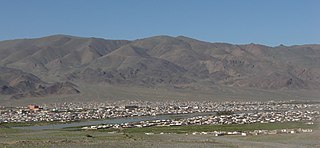
Bayan-Ölgii is the westernmost of the 21 aimags (provinces) of Mongolia. The country's only Muslim and Kazakh-majority aimag, it was established in August 1940. Its capital is Ölgii.

Leymus is a genus of plants in the grass family Poaceae (Gramineae). It is widespread across Europe, Asia, and the Americas.
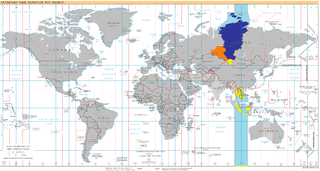
UTC+07:00 is an identifier for a time offset from UTC of +07:00. In ISO 8601 the associated time would be written as 2021-02-17T21:42:29+07:00. It is 7 hours ahead of the UTC, meaning areas in this time zone would be 07:00 while UTC is shown to midnight (00:00).

The Tavan Bogd is a mountain massif in Mongolia, near the triple border with China and Russia. Its highest peak, the Khüiten Peak, is the highest point of Mongolia at 4374 meters above sea level.

The Altaians are a Turkic people and related Mongols living in the Siberian Altai Republic and Altai Krai, Russia. A few Altaians also live in Mongolia and Northern Xinjiang, China but are not officially recognized as a distinct group. For alternative ethnonyms see also Teleut, Tele, Telengit, Black Tatar and Oirats.

Leonurus is a genus of flowering plants in the family Lamiaceae. It is native to Europe and Asia, naturalized in New Zealand, Hawaii, New Caledonia, and much of North and South America.
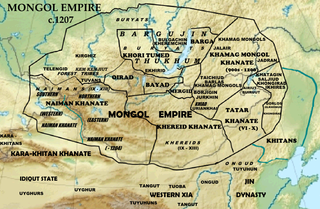
Uriankhai, Uriankhan or Uriankhat, is a term of address applied by the Mongols to a group of forest peoples of the North, who include the Turkic-speaking Tuvans and Yakuts, while sometimes it is also applied to the Mongolian-speaking Altai Uriankhai. The Uriankhai included the western forest Uriankhai tribe and the transbaikal Uriankhai tribe, with the former recorded in Chinese sources as 兀良哈.

Polygonia is a genus of butterflies with a conspicuous white mark on the underside of each hindwing, hence the common name comma. They also have conspicuous angular notches on the outer edges of their forewings, hence the other common name anglewing butterflies. The related genus Nymphalis also includes some anglewing species; Polygonia is sometimes classified as a subgenus of Nymphalis.
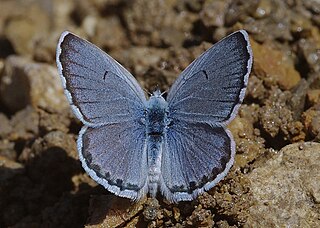
Pseudophilotes vicrama, the eastern baton blue, is a small butterfly found from Asia, east to Tian Shan and parts of China, west to the Balkans, Turkey, eastern Europe to southern Finland. It belongs to the lycaenids or blues family. The species was first described by Frederic Moore in 1865.
Hunting with eagles is a traditional form of falconry found throughout the Eurasian Steppe, practised by ancient Mongolic and Turkic peoples. Today it is practised by Kazakhs and the Kyrgyz in contemporary Kazakhstan and Kyrgyzstan, as well as diasporas in Bayan-Ölgii Provinces Bayan-Ölgii, Mongolia, and Xinjiang, China. Though these people are most famous for hunting with golden eagles, they have been known to train northern goshawks, peregrine falcons, saker falcons, and more.

Boloria is a brush-footed butterfly (Nymphalidae) genus. Clossiana is usually included with it nowadays, though some authors still consider it distinct and it seems to warrant recognition as a subgenus at least.

Khüiten Peak is the highest peak with 4,356 m above sea level and a permanent snow cap in the Altai Range, the international border between China and Mongolia runs across its summit point. It is also the highest point of Mongolia and Altay Prefecture in Western China.
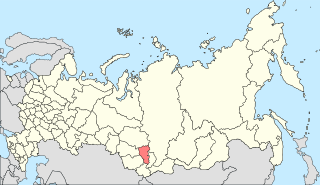
South Central Siberia is a geographical region north of the point where Russia, China, Kazakhstan and Mongolia come together.

The Altai Uriankhai refers to a Mongol tribe around the Altai Mountains that was organized by the Qing dynasty. They now form a subgroup in western Mongolia and eastern Xinjiang.

Chazara heydenreichi is a butterfly species belonging to the family Nymphalidae. It can be found from Hindu Kush and the W. Himalaya across Middle Asia and Kazakhstan to the S. Altai.

Oeneis magna is a butterfly of the family Nymphalidae. It was described by Ludwig Carl Friedrich Graeser in 1888. It is found from the Altai Mountains to southern Siberia and the Russian Far East, Mongolia, northern China and Korea. The habitat consists of sparse woodlands and mountain tundras.
Polygonia undina is a butterfly of the family Nymphalidae first described by Grigory Grum-Grshimailo in 1890. It is found from Ghissar-Darvaz to the Pamirs-Alai and Tian-Shan in north-western China and the Himalayas.
















